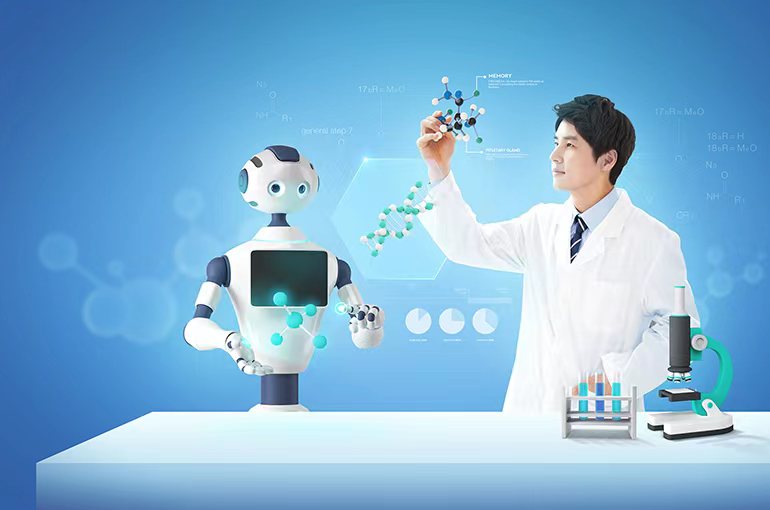 Evomics Medical's AI, Nuclear Medicine Are Game Changers Against Cancer
Evomics Medical's AI, Nuclear Medicine Are Game Changers Against CancerSome of the most innovative uses of artificial intelligence in healthcare today are in the field of nuclear medicine, and thanks to AI, nuclear medicine is demonstrating great potential for cancer treatment. There are around 20 million new cancer cases a year, and around 10 million deaths, which is around one in six of all deaths. The problem, and therefore the opportunity, is vast.
One of the leading companies in the field is Evomics, based in Shanghai and Vienna. It is using the same technology to develop both diagnostics and therapies, and it has ambitious plans for its EV101 compound, which it thinks could become a USD10 billion blockbuster.
It is easy to confuse nuclear medicine with radiation therapy, or radiotherapy. Radiotherapists bombard tissue with radiation from an external source in order to remove or reduce cancerous cells. Nuclear medicine, by contrast, injects radioactive molecules into the bloodstream, where they act as a drug. The radioactive molecule is known as a “radioligand” (from the Latin “ligare”, to bind), and it can perform a diagnostic function or a therapeutic one.
Once inside the body, the molecule “recognizes” proteins expressed by tumorous cells and binds to them. This causes the radioligand to decay, and emit positrons, the antimatter counterpart to electrons. When the positrons encounter electrons they annihilate each other, producing a pair of high-energy photons, which are detected by a device called a Positron Electron Tomography (PET) scanner. This is the diagnostic mode of nuclear medicine.
In therapeutic mode, the radioligand delivers a dose of radiation to the tumorous cell that it binds to, and causes it to die. The radioactivity is limited, so several rounds of treatment are usually needed to tackle the cancer.
Evomics uses the same compound for both diagnostic and therapeutic applications, but in different dosages. EV101 is the therapeutic application and EV201 is the diagnostic version. In combination they are known as a “theranostic” (therapy + diagnostic).
The proteins targeted by the Evomics radioligand are known as fibroblast activation proteins (FAPs). Fibroblasts are long, thin cells which normally help create tissue structure, including collagen, but when they malfunction they replicate uncontrollably, which is what causes cancer. The FAP targeted by EV101 and EV201 is associated with almost all forms of cancer.
Evomics’ CEO, Dr Shiwei Wang, co-founded the company with his twin brother Shifeng, and two Vienna-based professors of nuclear medicine, Dr Li Xiang and Dr Marcus Hacker. Before starting Evomics, Dr Wang spent a decade investing in biotech startups, while working in corporate development in the pharmaceutical industry. His employer was not a financial investor, but was looking to secure access to and experience of important emerging technologies. This gave Dr Wang privileged insights into the most promising new technologies. He decided that the combination of nuclear medicine and AI would generate enormous benefits for patients, and would fuel the rise of major new businesses.

(image: Dr Wang Shiwei)
Dr Wang started his new company with backing from his former employer, but Evomics remains low-profile at present, so its sources of funding are undisclosed at present.
During his stint in corporate development, Dr Wang collaborated with the venture capital community centred on Sand Hill Road in Silicon Valley, and one of the things he learned from them was that a great technology or a great product are not enough to guarantee success. In addition to that, a business founder needs exceptional motivation. Starting and growing a business is not for the faint-hearted: resilience and self-belief is essential for anyone who is trying to do things a new way. Dr Wang told me that he thinks his single greatest asset as CEO of Evomics is that “I don’t fear failure”. Interestingly, he thinks his self-confidence might stem in part from being a twin.
Deep learning AI systems are at the heart of Evomics’ philosophy, and essential to its work. They optimize the planning and preparation of medical interventions, analyze the images produced, and automate and accelerate the production of reports that clinicians can use. By making all stages of the process more efficient, the AI can reduce the number of scans required, and also the dosage of radiation the patient is subjected to. As we all know, speed is essential in cancer treatment, so by speeding up the analysis process and getting valuable insights to clinicians sooner, diagnoses can be made sooner and more accurately, and lives saved.
AI algorithms can also provide a valuable second opinion when clinicians disagree about the interpretation of images or data.
In future, Evomics is also working on the deployment of large language models, the transformer AI models which have captivated the world in the form of ChatGPT and GPT-4, to analyze and write up the findings of its other techniques.
The gamma rays given off by radioligands can be useful beyond cancer: Evomics is also developing software for SPECT imaging. SPECT stands for single-photon emission computed tomography, which can detect the presence of clogged arteries which could cause heart disease.
Significant challenges remain to the successful application of AI in nuclear medicine. The models become more effective when trained on large data sets, and the volume of data available today is limited, and it is rarely organized and labeled consistently. Most deep learning models are trained on two-dimensional images, but the scanned images from nuclear medicine are three-dimensional. And most important, patients, clinicians, and regulators must trust AI before it can be universally deployed. Understandably, many still regard AI systems as unexplainable black boxes.
These hurdles were reduced to some degree by the Covid-19 pandemic, which provided a significant boost to the use of AI techniques in medical imaging, including in nuclear medicine.
In 2016, AI researcher Geoff Hinton, known as the father of deep learning AI, famously said that “if you work as a radiologist you are like Wile E. Coyote in the cartoon. You’re already over the edge of the cliff, but you haven’t yet looked down. There’s no ground underneath.” He was wrong, in that today, seven years later, human radiologists are still in demand, and indeed many countries have a shortage of them. But as the cliché goes, even if AI won’t take your job any time soon, a human who knows how to work with AI probably will.
The bigger picture is that AI is making more and better technologies available, and we all benefit from that.